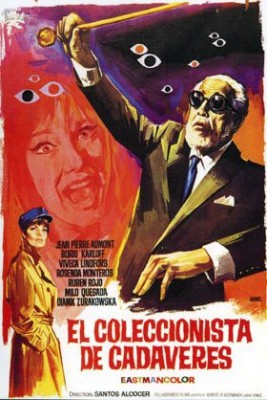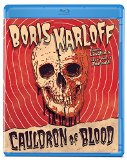| Reviews & Columns |
|
Reviews DVD TV on DVD Blu-ray 4K UHD International DVDs In Theaters Reviews by Studio Video Games Features Collector Series DVDs Easter Egg Database Interviews DVD Talk Radio Feature Articles Columns Anime Talk DVD Savant Horror DVDs The M.O.D. Squad Art House HD Talk Silent DVD
|
DVD Talk Forum |
|
|
| Resources |
|
DVD Price Search Customer Service #'s RCE Info Links |
|
Columns
|
|
|
Cauldron of Blood (aka Blind Man's Bluff)
Yet, Karloff soldiered on. Those three 1963 titles, tailor-made for the actor, were among his last worthy horror films. Except for the underrated Die, Monster, Die! (1965) and parts of The Sorcerers (1967), Karloff made no other significant horror films. A few projects worthy of his talents, such as narrating the perennial holiday special How the Grinch Stole Christmas! (1966), came along, and Karloff frequently guest-starred on various TV shows. Peter Bogdanovich's Targets (1967) was effectively Karloff's swan song, a self-referential drama with Karloff playing an anachronistic horror movie star in an America much more disturbing than his quaint, old-fashioned movies. It was his last American film.
After appearing in the forgettable British horror film Curse of the Crimson Altar (1968), all of Karloff's final movies were of Latin origin. Under the direction of Jack Hill, in the spring of 1968 Karloff shot scenes for four extremely bad and cheap Mexican movies, Fear Chamber, The Snake People, The Incredible Invasion, and House of Evil. Karloff's scenes were filmed in Los Angeles while the movies were otherwise entirely Mexican productions shot there.
Cauldron of Blood (1970), a Spanish-American coproduction filmed in Madrid, was apparently made prior to those four Mexican films, possibly before Targets and probably even before Curse of the Crimson Altar. However, Cauldron of Blood was one of three movies released long after Karloff's death in early 1969, the others being two of those Mexican productions.
The picture, also known as Blind Man's Bluff and, in Spain, as El coleccionista de cadáveres ("The Collector of Corpses"), has been a difficult movie to see since its original release, rarely turning up on television; I've been curious about it for 40 years. And I'm glad that I finally did see it, especially in high-def. That said, the movie is truly terrible, ineptly made and incoherent at times.
At 99 minutes, Olive Films' Blu-ray seems to be the longest version of the film, but that isn't necessarily a good thing. The plot is basically a reworking of countless Poverty Row horrors, and is egregiously padded. The Brute Man (1946), for instance, has similar elements, and so does Roger Corman's A Bucket of Blood, yet one could nearly fit a screening of both of those cheap films into a single screening of Cauldron of Blood.
Top-billed Jean-Pierre Aumont plays Claude Marchand, a free-lance photographer assigned to shoot and write a story about reclusive sculptor Franz Badulescu (Karloff), blinded in a car crash that served to enhance his fame. Semi-crippled, he lives on a lavish Moorish castle-like estate in Spain with his manager-wife (not his daughter, as the Blu-ray text claims), Tania (Viveca Lindfors), with whom he has a combative relationship.
Marchand and new lover Valerie (Rosenda Monteros, The Magnificent Seven) begin poking and prying around, and after what seems like hours and hours, begin to catch on to what the audience figured out ten minutes in. Unbeknownst to Franz, Tania is secretly having locals murdered, dissolving all but their skeletons in a vat of acid in the dungeon, and providing supposedly innocent castings to her clueless husband. Considering that she keeps a pet vulture around the house, you'd have thought he might have suspected something.
Bad as Karloff's Mexican films are, in some respects Cauldron of Blood is considerably worse. On one hand it stars three relatively major names - Aumont (who enjoyed a semi-successful Hollywood career), Karloff, and Lindfors - and a familiar one in Monteros. On the other the picture is occasionally incoherent and often downright amateurish, leaving one to wonder how this cast wound up in such a cheap, terrible film. Eugenio Martin's Spanish horror masterpiece Horror Express (1972) was made for probably even less money yet that film had the polish of a much more expensive film. Cauldron of Blood looks like it could have been produced by Harry Alan Towers and directed by Jess Franco. (It resembles both their collaborations as well as the Towers-produced Call of the Wild, which also somehow secured several big names.)
Almost everything about the film is astonishingly bad, to say nothing of torturously tedious. Mostly playing a victim to coded lesbian Tania's cruel machinations, Karloff has little to do until the end of the film, where the combination of his limited physicality and terrible direction, including a completely blown opportunity regarding the fate of his character, render the film a depressing, boring mess.
Every chance to spice the film up with a little suspense or even a few cheap shocks is squandered. A scene at a gypsy camp designed to generate some tension because the person relating important information is mute becomes a laughable game of charades. Tania's dream sequence, complete with sadistic lashing by her with a whip and a poor wax bust of Karloff's head, is like something out of Glen or Glenda? minus the fun. There are pointless cutaways to nothing in particular, from stock lighting bolts to lifeless crows. Bits here and there weakly imitate Mario Bava and there are gimmicky effects like freeze-frame shots intended for punctuation, but everything has minus-zero impact.
The score is equally poor, including a misplaced quoting of "Three Blind Mice," but, peculiarly, some of it later turned up as stock music in several Saturday morning kids shows produced by Filmation, including the animated Star Trek.
Video & Audio
For such a cheap, obscure film, Cauldron of Blood looks surprising good on Blu-ray. The film is in 1.66:1 widescreen and presented under that title rather than Blind Man's Bluff (for which I could locate no poster art at all). One of the first releases by Cannon Films, the title is now controlled in the U.S. by Paramount, even though MGM holds most of that library. Also curiously, the surprisingly elaborate credits call this "A Film by Edward Mann," but he only co-wrote the script; Santos Alcocer is the director of record. The opening titles are quite scratched up but the rest of the picture actually looks pretty decent, with most of the flaws clearly inherent to the original release. The mono audio is decent; a short scene is in Spanish and includes the original English subtitles. No Extra Features.
Parting Thoughts
Unless you're a hard-core Boris Karloff fan willing to sit through anything featuring the beloved actor, you'll not want to touch this with a ten-foot pole, even though the transfer is good. I'm glad to have finally seen it, but I doubt I'll ever want to look at again. Rent It.
Stuart Galbraith IV is the Kyoto-based film historian and publisher-editor of World Cinema Paradise. His credits include film history books, DVD and Blu-ray audio commentaries and special features.
|
| Popular Reviews |
| Sponsored Links |
|
|
| Sponsored Links |
|
|
| Release List | Reviews | Shop | Newsletter | Forum | DVD Giveaways | Blu-Ray | Advertise |
|
Copyright 2024 DVDTalk.com All Rights Reserved. Legal Info, Privacy Policy, Terms of Use,
Manage Preferences,
Your Privacy Choices | |||||||















